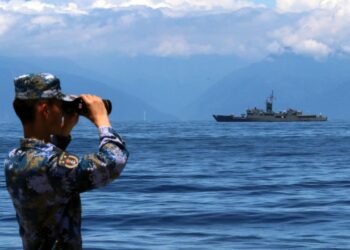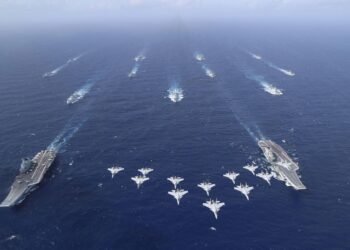Naval Submarine Forces Public Affairs,
Norfolk VA: The fast-attack submarine USS Scranton (SSN 756) successfully demonstrated homing and docking of an Unmanned Undersea Vehicle (UUV) system during at-sea testing in January 2006.
The two UUVs used in the testing are a part of the AN/BLQ-11 Long Term Mine Reconnaissance System (LMRS), which was designed to enable submarines to conduct clandestine undersea surveys to locate mines.
“The testing demonstrated several important capabilities of a submarine-launched UUV system,” said Capt. Paul D. Ims Jr., program manager for UUVs in the Program Executive Office for Littoral and Mine Warfare. “These included the ability of the submarine to prepare and then launch an autonomous UUV from her torpedo tubes, and the ability of the submarine to rendezvous with an autonomous UUV and then control the UUV with an underwater acoustic communication system.”
According to Ims, repeated homing tests were conducted with slightly different configurations to assess the ability of a UUV to dock with a torpedo-tube-mounted recovery system. The final result was the first successful docking of the LMRS vehicle to a submerged submarine at-sea.
“This was a big step forward,” Ims said. “The Navy is making significant progress in the development of Unmanned Undersea Vehicles, especially in the mission areas of reconnaissance, surveillance and anti-mine warfare.”
“Our UUV programs are focused on delivering more affordable, modular, autonomous systems with an open architecture.”
After the UUV is launched from the submarine's torpedo tube, it transits to a series of pre-programmed waypoints. Meanwhile, the submarine maneuvers to rendezvous with the UUV. Homing and Docking sonar guides the UUV towards the recovery arm, a unique docking mechanism that extends out of the ship's upper torpedo tube. After the UUV is captured, the recovery arm guides the UUV into the lower torpedo tube, and back into the submarine.
“Achieving the first successful at sea docking of an autonomous UUV with a submarine was the result of a seamless joint effort between Scranton and the LMRS team,” said Cmdr. Mike Quinn, commanding officer, Scranton.
“Submarine missions are increasingly focused on generating real-time, actionable intelligence and the ability to launch and recover autonomous, re-useable UUVs with various mission payloads will improve our ability to provide the theater commanders with the information they need to successfully conduct pre-cursor, as well as combat operations.”
“Improvements in autonomy — the artificial intelligence that enables UUVs to function beneath the water for long periods of time without communication with human operators — will enable UUVs to accomplish very sophisticated missions with complex payloads,” Ims added.
The LMRS test demonstrated technologies possible from completely autonomous UUVs. Once launched, there are no wires connecting them to the submarine. The UUVs can monitor and control their position using sophisticated inertial navigation systems and GPS receivers. Forward and side scanning sonars enable obstacle avoidance, and communications are accomplished via acoustic and UHF satellite communications systems.
An average of 10 attack submarines are deployed globally at any given time, performing a variety of missions in support of national security and the global war on terrorism. UUVs are just one of the multi-mission payloads submarines bring to the joint warfighting arena.
“Unmanned Undersea Vehicles will extend the submarine's stealthy reach, across both the depth and breadth of the littoral battlespace,” Ims stated. “Acting as a clandestine, autonomous, mobile sensor, networked into the Global Information Grid, UUVs will provide unprecedented improvements in battlespace awareness.”
The variety and complexity of missions that a UUV can perform will provide the area commanders a valuable tool in Intelligence, Surveillance and Reconnaissance (ISR) and other littoral operations.
“UUVs will play a major role in assuring access to the littorals and enabling U.S. Joint Forces to project power from the sea to inland objectives,” Ims said.
“Mine Countermeasure and ISR mission capabilities will be delivered first, followed by expansion into other warfighting missions through development of modular payloads,” he added. “UUVs will provide the submarine force with access to littoral battlespace that is too shallow for submarine operations or is otherwise inaccessible.”
“With FORCEnet connectivity, UUVs will be a force multiplier, enabling a single submarine to simultaneously provide clandestine presence in multiple locations.”
Several critical lessons were learned during these tests, including management of the interaction that occurs when a UUV comes very close and then docks to a submerged submarine, the integration of UUV systems within the submarine and the performance of UUV acoustic communication and homing systems.
All of these lessons learned are being used to continue the development of UUVs for today's submarine force and looking at future capabilities and technologies for the next generation of UUVs.
“Advances in autonomy software, energy systems, sensor design and computer processing technology will make it possible to pack ever-increasing capability into smaller, cheaper UUVs,” Ims explained.
“These improvements will also enable a UUV of a given size to have longer endurance or carry more payload,” he continued. “Unmanned vehicle systems must employ modular hardware and software design, and an open system architecture that will support rapid, affordable insertion of new technologies and payloads.”
“The follow on applications for this technology and capability in the submarine force are limitless,” Quinn added.









